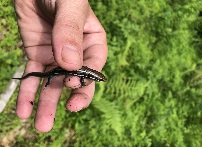Northern Coal Skink (Plestiodon anthracinus anthracinus)
Description: Gray to brown with four light tan to olive brown stripes on the body that extend down the tail. The sides of the males head will turn reddish during the mating season. The young have a blue tail. The underside from the chin to the tip of the tail is blueish grey to grey. The limbs are similar in color to the dorsal stripe. Melanistic individuals have been recorded. Coloration can vary with sex and age. The dorsal has a broad light tan to olive brown stripe that extends from the top of the head to the dorsal surface of the tail. The dorsal stripe is bordered on both sides by a white to yellow line that extends from the posterior margin of the eye to the anterior region of the tail. A series of black dots may occur along the medial sides of these lines.
A second pair of lines runs along the ventral lateral margins of the body that extend from the posterior margins of the ear to the anterior portion of the tail.
A broad bark brown to black stripe occupied the space between the dorsal and ventral lateral lines. These stripes extend from the head and onto the tail.
The ventral color from the chin to the tip of the tail is blueish grey to grey. The limbs are similar in color to the dorsal stripe. Neonates have a more intense color with black limbs and a cobalt blue tail. The blue is lost once they mature. Males will have a orange-red color on the sides of the head during mating season.
Habitat: The more humid portions of wooded hillsides with abundant leaf litter or loose stones are favorite habitats. Coal skinks' habitat may also include areas around springs and rocky bluffs overlooking creek valleys. If pursued, they will take refuge in shallow water, going to the bottom and hiding under stones or debris.
Range: The northern coal skink (blue in the figure) occurs in western New York and central Pennsylvania and in isolated colonies in the Appalachians.
Diet: Coal skinks presumably prey on a wide variety of insects, spiders, and other invertebrates.
Reproduction: The coal skink mates in spring or early summer, laying a clutch of 8 or 9 eggs. The young hatch after four to five weeks and are about 2.0 inches long. The hatchlings have a blue tail; those of the northern coal skink are striped like the adults. Mating ocurs in late winter and early spring. Lays clutch of about 6-11 eggs, April-June; eggs hatch in about 5 weeks; female attends eggs during incubation.
Status: Listed as Least Concern in view of the large and apparently relatively stable extent of occurrence, area of occupancy, number of subpopulations, and population size. No major threats are known.
»» Kingdom: Animalia - Animals
»» Phylum: Chordata - Chordates
»» Subphylum: Vertebrata - Vertebrates
»» Class: Reptilia - Reptiles
»» Order: Squamata - Lizards
»» Family: Scincidae - Skinks
»» Genus: Plestiodon
»» Species: Plestiodon anthracinus - Coal Skink
»» Subspecies: Plestiodon anthracinus anthracinus - Northern Coal Skink
This article uses material from the Wikipedia article "Plestiodon anthracinus", which is released under the Creative Commons Attribution-Share-Alike License 3.0. Content may have been omitted from the original, but no content has been changed or extended.
|







